Ghodssi R., Lin P., MEMS Materials and Processes Handbook
Подождите немного. Документ загружается.

1004 P. Lin e t al.
[208] investigated copper CMP in alkaline conditions and proposed that success-
ful copper CMP slurry should ensure that all materials dislodged from the copper
surface are dissolved, to avoid the re-deposition of copper oxide particulates. Re-
deposition significantly reduces the effectiveness of mechanical abrasion and thus
lowers the material removal rate. Seal [209] and Park [210] studied the effect of
H
2
O
2
on the copper CMP process in acidic conditions. The results demonstrated that
slurry chemistry can change the polishing mechanism in CMP. More specifically, at
low H
2
O
2
concentrations, the copper removal is strongly dissolution-dependent. At
higher H
2
O
2
concentrations, a protective oxide film rapidly forms on the copper
surface and prevents heavy dissolution. In this case, the process is controlled by
mechanical removal of copper and subsequent dissolution. At intermediate concen-
trations of H
2
O
2
, both polishing mechanisms coexist and compete. Kikkawa [211]
studied the effect of slurry chemistry on mechanical abrasion during copper CMP
with the in situ frictional force measurement technique. Slurry chemistry was found
to strongly affect the formation of a passivation film on the copper surface and thus
change the friction force of the surface.
13.7.1.2 Mechanics of CMP
During the CMP process, the wafer, pad, and slurry constitute a classical tribolog-
ical system, normally regarded as a three-body interface with two solids in relative
motion and slurry at the interfaces [212, 213]. The Preston Equation is the most fre-
quently referenced expression for polishing rate in CMP [214, 215]. The equation
states:
R = KPV (13.53)
where R is the removal rate, P is the pressure, V is the linear velocity of the pad
relative to the workpiece, and K is the Preston coefficient. According to Equation
(13.53), polishing rate is directly proportional to both the velocity of the pad and the
pressure. However, this equation does not agree with experimental results when the
velocity and/or pressure approaches zero. In order to account for this phenomenon,
Steigerwald et al. [208] proposed the following modified Preston Equation:
P = (K P + B)V + R
C
(13.54)
where B is a proportionality constant and R
c
is the chemical removal rate.
The correlation between polishing conditions and polishing results is widely
studied. Figures 13.50–13.53 show results from several representative studies for
silicon dioxide, tungsten, and copper polishing.
In oxide polishing (Fig. 13.50), water reacts with the wafer surface and con-
verts some Si-O-Si molecules to Si-OH. The hydrated sites are softer than the
original surface [216]. Figure 13.50 shows the variation in normalized material
removal rate with respect to the diffusion coefficient of water and the applied
pressure. When using a high diffusion coefficient, a higher material removal rate
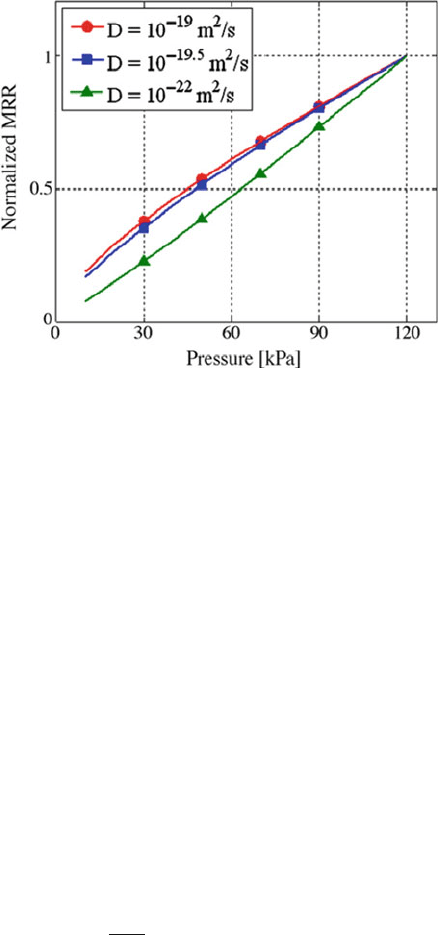
13 Surface Treatment and Planarization 1005
Fig. 13.50 Normalized oxide
polishing rate vs. polishing
pressure for slurries of
various diffusion coefficients
[216]. Reprinted with
permission. Copyright 2009
Elsevier
was achieved, as the soft hydrated layer formed faster than it could be removed.
Under these conditions, the change in material removal rate with respect to applied
pressure gradually decreased with increasing pressure. In the low diffusion coeffi-
cient regime, lower material removal rates were observed. In this case, the material
removal rate depended primarily on the mechanical action of the abrasive particles,
resulting in near-Prestonian behavior. Figure 13.51 shows contours of the polish-
ing rate and process temperature for IC-1400 pads (top) and Politex pads (bottom)
in tungsten CMP. Polishing rate and process temperature increased with applied
pressure and table rotation rate.
Figures 13.52 and 13.53 demonstrate the dependency of polishing rate on table
speed and applied pressure in copper CMP. While the linear behavior is consistent
with the Preston Equation (13.53), close inspection of the curves reveals that the
Preston Equation is not applicable. The removal rate has a non-zero intercept at
both zero rotation rate and zero pressure. The modified Preston Equation (13.54)
accounts for these results.
Table 13.9 shows several examples of polishing condition setups for materi-
als used in MEMS fabrication. The platen speed refers to the table or pad speed,
whereas the carrier speed is the wafer rotation speed.
The Stribeck curve (Fig. 13.54) was developed to monitor tribological processes
[219]. The Sommerfeld number (S
f
) is defined as
S
f
=
μU
pδ
eff
(13.55)
where μ is the viscosity of the lubricant, U is the relative velocity, p is the applied
pressure, and δ
eff
is the effective lubricant film thickness.
In the three-body interface system, i.e., the wafer-slurry-pad system, t he solid
bodies may interact in three lubrication regimes, as shown in Fig. 13.54:(1)
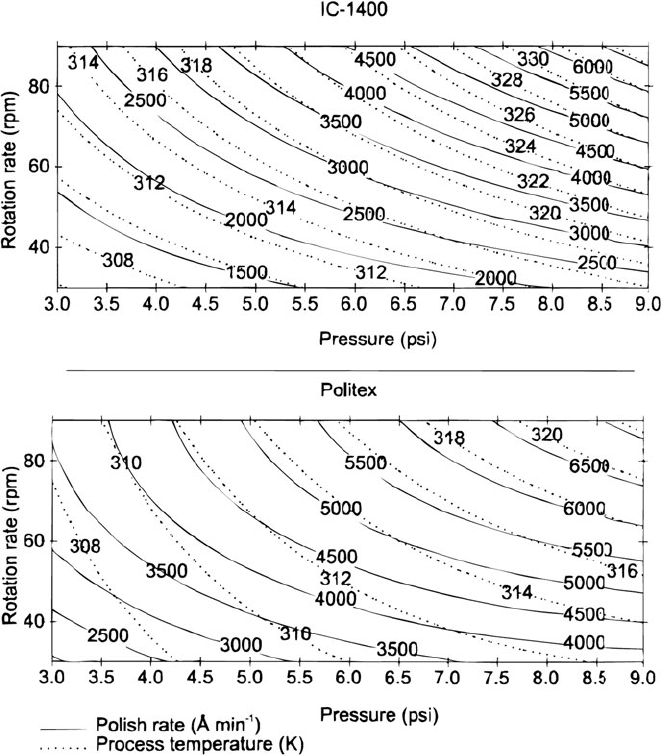
1006 P. Lin e t al.
Fig. 13.51 Material removal rate and process temperature for t ungsten polishing with commercial
slurries [217]. Reprinted with permission. Copyright 1999 ECS
boundary lubrication (solid-solid contact), (2) partial lubrication (semi-direct con-
tact), or (3) hydrodynamic lubrication (hydroplanes interacting with each other). In
boundary lubrication, the wafer and pad are involved in solid-solid interaction, and
the material removal rate is determined by surface abrasion only. In this regime,
the transport of slurry under the wafer is poor, resulting in limited chemical activ-
ity. Also, the elevated temperature and aggressive abrasion of pad and particles can
cause severe surface damage on the polished substrate. In the mixed (or partial)
lubrication regime, a thin slurry film partially supports the applied pressure, prevent-
ing aggressive abrasion of the polished surface. The thin slurry layer is beneficial
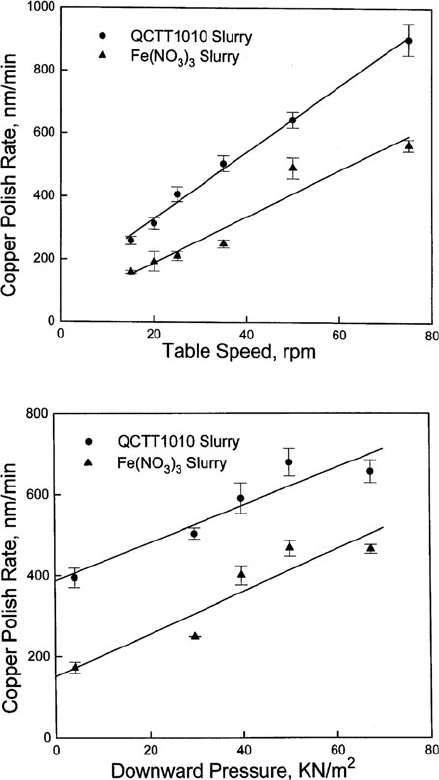
13 Surface Treatment and Planarization 1007
Fig. 13.52 Effect of table
speed on copper polishing
rate with QCTT1010
commercial slurry and
Fe(NO
3
)
3
slurry. Polisher
settings: 0 in. oscillation,
210 ml/min slurry flow rate,
SUBA IV pad and 30 KN/m
2
downward pressure [218].
Reprinted with permission.
Copyright 1998 Elsevier
Fig. 13.53 Effect of applied
pressure on copper polishing
rate using QCTT1010
commercial slurry and
Fe(NO
3
)
3
slurry. Polisher
settings: 0 in. oscillation,
210 ml/min slurry flow rate,
SUBA IV pad and 35 rpm of
the table. Fe(NO
3
)
3
slurry:
0.005 M BTA, 0.1 M
Fe(NO
3
)
3
, pH 1.35, 100 nm
α-alumina particles [218].
Reprinted with permission.
Copyright 1998 Elsevier
for two reasons. First, it acts as lubricating agent and conducts heat away from the
surface; second, slurry transport is more efficient when such a fluid layer exists.
In the hydrodynamic (hydroplaning) regime, the applied load is completely sup-
ported by a thick slurry layer at the interface. This layer may s ignificantly reduce the
material removal rate due to the low coefficient of friction. Philipossan et al. [220]
investigated the effect of surfactant, abrasive size, abrasive content, wafer pressure,
and sliding velocity on the frictional and kinetic attributes of copper CMP. It was
shown that although abrasive content did not affect the tribological mechanism of
the process, abrasive size was a significant factor. Surfactant-containing slurries dra-
matically reduced the coefficient of friction. Wang et al. [221] studied the effect of
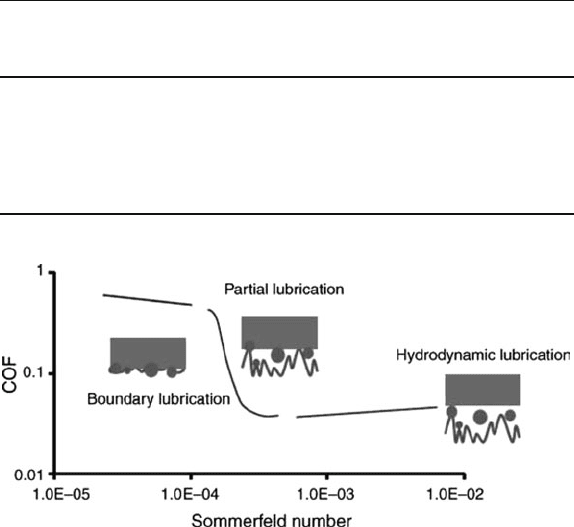
1008 P. Lin e t al.
Table 13.9 Examples of CMP settings for different materials on 200 mm wafer
Material
Platen speed
(rpm)
Carrier speed
(rpm)
Down
pressure
(psi)
Slurry flow
(ml/min)
SiO2 95 87 3–5 200
W 75 70 4–7 200
Cu 85 75 1.5–2 200
Ta, TaN 100 100 1.5–2 200
Poly Si 50 50 2 200
NiFe 80 70 4–8 200
Fig. 13.54 Three modes of contact experienced during CMP [222]. Reprinted with permission.
Copyright 2003 JJAP
pad grooves on slurry flow at the pad-wafer interface. It was demonstrated that the
pad groove generally increased slurry flow rate and slurry suction at the pad-wafer
interface.
13.7.2 Applications
Many MEMS fabrication techniques have been adopted from the field of micro-
electronics manufacturing, while a significant number of fabrication methods have
also been developed to fulfill functional requirements for mechanical, electri-
cal, optical, and sensor structures. Bulk micromachining, surface micromachining,
and micromolding are commonly used in MEMS fabrication. During these pro-
cesses, high surface topography is created and hinders subsequent processes such
as thin film deposition and microlithography. Thus, CMP is an enabling technol-
ogy when smooth or planar surfaces are required. Planarization can be categorized
into three levels, as shown in Fig. 13.55: smoothing, local planarization, and global
planarization [208, 220, 223].

13 Surface Treatment and Planarization 1009
Fig. 13.55 Degree of
planarization in the CMP
process [208]. Reprinted with
permission. Copyright 1997
John Wiley & Sons, Inc
The degree of planarity is determined by considering the geometry of the pol-
ished surface, as shown in Fig. 13.56. The planarity is ranked using the values of
planarization length R and planarization angle θ [224]:
• Surface smoothing: 0.1 μm < R < 2.0 μm and 30
◦
<θ.
• Local planarization: 2.0 μm < R < 100 μm and 0.5
◦
<θ<30
◦
.
• Global planarization: 100 μm << R and θ<0.5
◦
.
13.7.2.1 Smoothing and Local Planarization
Smoothing is the lowest level of planarization, in which sharp features are smoothed
and high aspect ratio holes are filled. For sub-micron metallization schemes, CMP
Fig. 13.56 Quantified
measurement of planarity
[224]. Reprinted with
permission. Copyright 1991
ECS
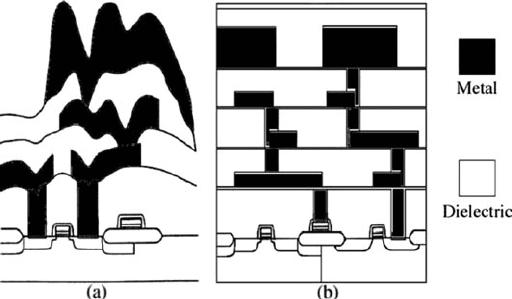
1010 P. Lin e t al.
is utilized to smooth the surface and to fill contact and via holes, avoiding poor step
coverage, which can lead to high current density and electromigration. In multi-
level metallization, simple smoothing is insufficient, since uneven topography can
be cumulative through many metal layers. Therefore, local planarization must be
achieved.
13.7.2.2 Global Planarization
In the microelectronics industry, the critical dimensions of circuits are constantly
reduced as technology advances. This adds to the challenges of the lithography pro-
cess. In order to minimize the focusing inaccuracy, many enhancement techniques,
such as phase-shift masks and immersion lenses, are utilized along with deep UV
(193 nm wavelength) lithography tools. However, the introduction of these enhance-
ment techniques significantly reduces the depth of focus in lithography. Typically,
lithography tools need to work at a depth of about 270 nm across a 20 mm by 20 mm
stepper field. Smoothing or local planarization is not adequate in this regime, and
global planarization is required for successful patterning. With finite depth of focus
in lithography, any uneven topography and roughness will lead to a reduction in
focusing accuracy and inaccurate patterning [220]. Figure 13.57a, b show a com-
parison between planarized and non-planarized surface topography. In practice, the
pattern density within the die significantly affects the results in global planariza-
tion. In order to avoid variations in removal rate or step height caused by varied
pattern densities, the selection of suitable consumables and process optimization
is essential. One method used to minimize variations in pattern density is to mix
dummy structures with the main patterns [225].
Fig. 13.57 Schematic of a MLM structure (a) without and (b) with planarization [226]. Reprinted
with permission. Copyright 2003 Peter Walters
13 Surface Treatment and Planarization 1011
13.7.2.3 Trench Fill
Trench fill technology was first developed for microelectronics manufacturing.
LOCOS (local oxidation of silicon) and Shallow Trench Isolation (STI) are the
two main lateral isolation techniques. When dimensions are smaller than 0.25 μm,
the so-called “bird’s beak” in LOCOS limits its applications, and STI with CMP
is adopted as a replacement. The first step of the STI process is etching of
the silicon substrate to form trenches; this process is followed by refilling the
trenches with oxide. After the trenches are refilled, CMP is used to remove
the overburden oxide and achieve a planar surface. The implementation of cop-
per interconnects on chips is realized by damascene technology. Damascene is
conceptually similar to STI technology, comprising trench etching, copper refill,
and CMP.
MEMS technologies rely largely on developments in microelectronics man-
ufacturing. The above-mentioned technologies have thus found their way into
various MEMS applications. However, trenches in MEMS fabrication are much
deeper than those encountered in integrated circuit fabrication, and CMP pro-
cesses must be adjusted to fulfill MEMS-specific requirements. Three-dimensional
integration by chip stacking has recently gained much interest. Through-silicon
via (TSV) has been adopted as one possible solution to achieve vertical inter-
connections. TSV relies on the same basic concept as copper damascene, but
the vias are deeper and larger (20–100 μm in diameter) than the interconnect
trenches on chips. After the vias have been filled, the copper overburden is
removed by CMP; r equirements for this process are comparable to those in MEMS
applications [227].
13.7.3 Pads and Slurry
As discussed in Section 13.7.1.2 (Mechanics of CMP), pad, slurry, and wafer con-
stitute the most important three-body interfaces in the CMP process. CMP involves
both chemical and mechanical effects, and therefore polishing pads must have suffi-
cient chemical inertness and mechanical resistance to survive the rigors of polishing.
The preferred mechanical properties for polishing pads include high strength (to
resist tearing during polishing), suitable hardness, and good abrasion resistance to
minimize pad wear during polishing and conditioning. In terms of pad chemistry,
the pad must be inert enough to survive aggressive slurry chemistries used in CMP
without becoming damaged through degradation or delamination. Another impor-
tant criterion is pad wettability. The pad must be hydrophilic, to ensure the spread
of slurry on the platen. Otherwise, the slurry will be swept away before forming the
hydroplane that allows the synergistic combination of chemical effects and mechan-
ical abrasion. Researchers have investigated a number of polymers as polishing
pad materials, including polyethylene, PTFE, and others. Polyurethane stands out
due to its durability, excellent chemical stability, and adaptability of properties and
micro/macro structures.

1012 P. Lin e t al.
There are four types of pads currently available, grouped by microstructure and
physical and mechanical properties:
Type I: Felts and polymer-impregnated felts
Type II: Porometrics (microporous synthetic leathers)
Type III: Filled polymer sheets (films)
Type IV: Unfilled textured polymer sheets (films)
Key features, properties and typical applications for the four main pad types are
summarized in Table 13.10.
The relationship between polishing performance and pad properties is com-
plex and not yet fully understood. First, polishing performance is measured by
several parameters that are not only related to pad properties, but are also depen-
dent on polished feature size and substrate size. Second, other factors such as
slurry (pH, abrasive size, additives), polishing tool (polisher, conditioner, retaining
ring), and polishing conditions (platen speed, flow rate, pressure) also have sig-
nificant effects on polishing results. Nevertheless, the major relationship between
pad properties and polishing performance are still important as guidelines in CMP
applications, and are summarized in Table 13.11. In practice, a stiff pad is preferred
Table 13.10 Key features, properties and applications for different pad types [228]
Type I Type II Type III Type IV
Structure Felted fibers
impregnated
with
polymeric
binder
Porous film
coated on
supporting
substrate
Microporous
polymer sheet
Nonporous
polymer sheet
with surface
macrotexture
Microstructure Continuous
channels
between fibers
Vertically
oriented open
pores
Closed-cell foam None
Inherent
microtexture
High High Medium Low
Slurry holding Medium High Low Minimal
Example of
commercial
pads
Suba
TM
STT 711
TM
Pellon
TM
Politex
TM
Surfin
TM
UR100
TM
WWP3000
TM
IC1000
TM
IC1010
TM
IC1040
TM
FX9
TM
MH
TM
OXP3000
TM
OX4000
TM
NCP-1
TM
IC2000
TM
Compressibility Medium High Low Very low
Stiffness/hardness Medium Low High Very high
Typical
applications
Si stock
polishing,
Tungsten CMP
Si final polishing,
Tungsten
CMP, post
CMP buff
Si stock, ILD
CMP, STI,
metal
damascene
CMP
ILD CMP, STI,
metal dual
damascene
Reprinted with permission. Copyright 2007 John Wiley & Sons Inc

13 Surface Treatment and Planarization 1013
Table 13.11 Relationship between pad property and polishing performance [228]
Polishing scale
Pad property Wafer Die Feature Conditionability
Density
(porosity)
Removal rate,
nonuniformity
Defectivity Dishing, erosion Yes
Hardness Macroscratches Defectivity Defectivity,
roughness,
dishing,
erosion
Yes
Tensile strength Pad life Yes
Abrasion
resistance
Pad life Yes
Modulus
(stiffness)
Edge effects Planarization Yes
Thickness Pad life
Top pad com-
pressibility
Planarization Dishing
Pad texture Pad life, removal
rate,
nonuniformity,
edge effects
Pad roughness Removal rate,
nonuniformity
Planarization Dishing,
erosion
Yes
Hydrophilicity Removal rate Yes
Reprinted with permission. Copyright 2007 John Wiley & Sons Inc
to achieve ideal planarization and avoid unwanted results such as dishing in metal
polishing, which is related to pad bending. However, wafers are not perfectly flat
and typically have some degree of curvature due to the stresses introduced dur-
ing manufacture and coefficient of thermal expansion mismatch in the deposited
oxide and metal layers. Therefore, sufficient pad flexibility is required to account
for variability in wafer flatness. The solution used in industry is to laminate a
stiff pad onto a flexible base pad. One representative example of such a com-
bination is t he IC1000/SUBA IV pad, which is widely used in both oxide and
metal CMP.
Slurry plays a very important role in the CMP process. Though many advanced
technologies are currently employed to prepare high performance slurries, slur-
ries all consist of the same major components: a solution and an abrasive [223].
The abrasive in slurry mechanically abrades the wafer surface and removes sur-
face material. Chemical additives in the slurry react with surface material to enable
planarization of the substrate. Also, chemical additives work along with abra-
sives to minimize the redeposition of polishing debris onto the substrate. An ideal
slurry is expected to simultaneously produce a high material removal rate, few sur-
face defects (scratches, corrosion, and other defects), high wafer uniformity, and
high selectivity with respect to the underlying layers [228]. Other important slurry
